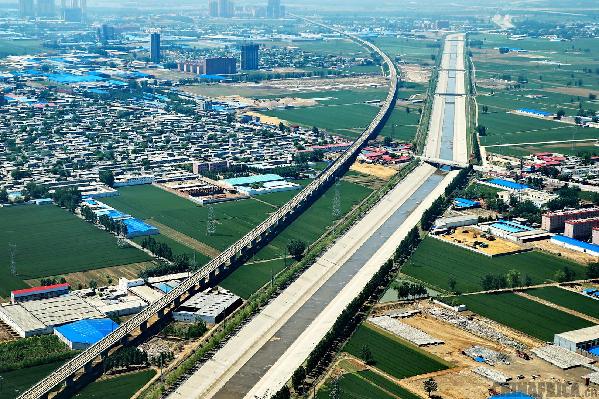| 
The main canal in the middle route of the south-to-north water diversion project runs parallel to the express railway that connects Beijing and Shijiazhuang, capital of Hebei Province
Imagine Beijingers drinking water brought to the capital from more than 1,000 km away, from the Danjiangkou Reservoir on a branch of the Yangtze River in Hubei Province! Incredible but now it becomes true.
Water through the south-to-north diversion project arrived in Beijing on December 28, 2014. The water diversion project, under construction since the early 2000s, has seen the completion of its first phase. People in Beijing and other dry areas in north China are finally able to drink water from the Yangtze River. The project, the largest of its kind in the world, is designed to take water from the country's longest river to the dry areas in the north.
It has three routes: eastern, middle and western. Construction of the eastern route started in 2002, with the middle one following in 2003. Work on the western route is yet to begin.
Upon completion, the project is expected to divert up to 44.8 billion cubic meters of water per year to more than 10 provinces, autonomous regions and municipalities, benefiting nearly 100 million people. Up to 600,000 jobs are expected to be created.
Engineering marvels
The project was approved by the State Council in December 2002, after nearly half a century of debate. It will run across the watershed of four major rivers - the Yangtze, Huaihe, the Yellow River and the Haihe.
Due to the immense length of the water diversion line and the large area it will cover, the project involves a broad range of engineering techniques: the construction of reservoirs, lakes, canals, watercourses, dams, pumping stations, tunnels, aqueducts, culverts, inverted siphons, channels and much more.
The first stage in the eastern route became operational in 2013, sending water to east China's Shandong Province. The middle route is the most attention-grabbing as it takes water to the capital. The main canal on this route is 1,432 km long with a 1,196.36-km open channel.
In the first stage, the middle route will pump almost 9.5 billion cubic meters of water - one-sixth the volume of the Yellow River - to the parched north every year, covering over 20 major cities via canals and pipes from the Danjiangkou Reservoir.
Beijing's per-capita water resource is less than 100 cubic meters, far below the 500 cubic meters, which is considered acute water shortage by international standards.
On December 12, 2014, over 1,400 km of canals and pipelines began carrying water from the Yangtze to the north, a feat hailed as a major victory. President Xi Jinping sent his congratulations, saying the success had come through ceaseless effort by hundreds of thousands of people.
A thirsty city
Beijing needs at least 3.6 billion cubic meters of water a year for its 20 million residents and local businesses. But in the past decade it got only 2.1 billion cubic meters annually.
"The city is facing a severe water crisis," said Xu Xinyi, a water conservancy specialist with Beijing Normal University. "It's like five people being stuffed into a room designed for two."
The Yangtze water will make up a third of Beijing's total supply, hopefully narrowing the huge gap between its annual water demand and supply. With the Yangtze water piping in, the capital will have 150 cubic meters per person, an increase of 50 percent, according to figures provided by the Beijing water authority.
Its neighboring province Hebei will also benefit with the supply of more than 3 billion cubic meters of water annually.
"It will alleviate the water shortage in Hebei and help promote sustainable development in the local society and economy," said Zhang Qingwei, Governor of the province.
Water Diversion Project in a Nutshell
» December 28, 2014: Water through the south-to-north diversion project arrived in Beijing.
» December 25, 2013: The main work on the middle route is completed.
» September 2012: Relocation of residents near the Danjiangkou Reservoir is completed.
» March 31, 2010: All 54 dams of the Danjiangkou Reservoir are raised from 14.6 meters to 176.6 meters to store up to 29 billion cubic meters of water from rivers including the Hanjiang, a major tributary of the Yangtze.
» February 26, 2009: Major work on the middle route spreading over seven provinces starts.
» September 26, 2005: The dams of the Danjiangkou Reservoir begin to be expanded to increase storage capacity.
» December 30, 2003: Work on the first phase of the middle route begins.
» December 27, 2002: Construction starts on the eastern route in Shandong and Jiangsu provinces.
» December 23, 2002: The State Council approves the project.
» June 5, 2000: After decades of research and discussion, it is decided the south-to-north water diversion project will have three routes - eastern, middle and western.
(Source: Xinhuanet.com) |